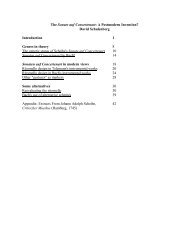SEVEN PAPERS ON EXISTENTIAL ANALYSIS ... - Wagner College
SEVEN PAPERS ON EXISTENTIAL ANALYSIS ... - Wagner College
SEVEN PAPERS ON EXISTENTIAL ANALYSIS ... - Wagner College
Create successful ePaper yourself
Turn your PDF publications into a flip-book with our unique Google optimized e-Paper software.
is or the lived body is the body that moves, exercises, performs, makes love, fights. Transitive<br />
action verbs are used to describe it. The body one is speaks words and announces nonverbally<br />
what the person may not have the words to express. The existential therapist attempts to help<br />
the person become aware of the body he is.<br />
Only others have direct access to the body one is. For ease of exposition, let me put this<br />
in first-person terms. Only an other hasaccess to the body I am. I am barred from it by the body I<br />
have, which dominates my world as the embodiment of my past. To the extent that I have<br />
access to the body I have, I also have access to my lived time. What I do not have access to is<br />
my<br />
existential body or lived body. I regularly come to know about my existence from others, just as I<br />
first had my existence bestowed on me by another, the mothering figure of my infancy. These<br />
fundamental experiences of validation become the focus of existential therapy, in which the<br />
patient comes to recognize the encounters in which his existence was and is bestowed on and<br />
reaffirmed in him and in which he at the same time bestows existence on others.<br />
With respect to what I am, the body I have is the most important thing in my world, but<br />
from the perspective of my existence it may not be. My existence is constantly manifesting itself<br />
as, for example, a religious, political, moral, philosophical, or scientific life. Like a flame, my<br />
existence plays on the surface of things that comprise my world, including the body I am. It<br />
gives these things the meaning they have in consonance with my existence. Existence occurs at<br />
the things that encounter me, including the body I have. Thus, my existence does not occur<br />
“inside” me or my psyche, or “inside” my body. The image of the person as a container for<br />
hidden processes (the word ‘person’ derives from the Latin persona, which means a mask) has<br />
obscured the fact that my existence is out here [da], at the things that encounter me, once<br />
again, including the body I have. A person’s existence occurs between it and another person’s<br />
existence, at the things with which we deal together, including the bodies we are. Existence<br />
occurs between pairs of people, just as it originated for each of us in the dyad of infant and<br />
mothering figure. Existential validation, including its occurrence in the therapeutic setting, as we<br />
will see, is always a two-person phenomenon. As Buber said: “In the beginning was the we.”<br />
The patient’s body eventually betrays the lack of an interior. The hidden parts of the<br />
body he has are, of course, covered by integument and skeletomuscular structure, but this is not<br />
what people have in mind when they talk about what is going on “inside,” “in” their “inner<br />
world” of affects, images and thoughts – the so-called representational world. The introspective<br />
turn is once again the legacy of Descartes. To his great disappointment, the patient finds that<br />
there is nothing “inside” himself except physical organs and empty spaces. While the body I<br />
have (including its hidden parts) is one of the things (and a very important thing at that) at<br />
which my existence takes place, it is not the only thing that confronts me and, most of the time,<br />
it is not the most important site of my existence. When my existence becomes an issue for me,<br />
however, that is to say, in instances of existential pathology, the body I have tends to take<br />
center stage because it has become objectified as the body I have. Rarely is the body one has<br />
not a major focus for the person whose existence is disturbed. Increased interest in the body<br />
one has is a consequence of increasing estrangement from one’s existence. We see this in<br />
extreme instances in so-called hypochondriasis.<br />
Existence also occurs, of course, at many other things, including especially the body the<br />
other has. For each of us, the earliest of these sites is, of course, the mothering figure’s body and,<br />
later, at what the British psychoanalyst Donald Winnicott called transitional objects. The<br />
expanding and contracting world of the older child and of adults encompasses innumerable<br />
sites where one’s existence occurs. These are the things that comprise one’s world, and being in<br />
a world, as Heidegger says, is the essence of existence. What disturbs the patient who seeks<br />
attention is a change in the things that comprise his world. The disturbed world, which is a<br />
correlate of one’s lived time, has changed tout court, and in such a way that the person has<br />
been unable to appreciate the change. Please notice that I did not say “the disturbed person.”















